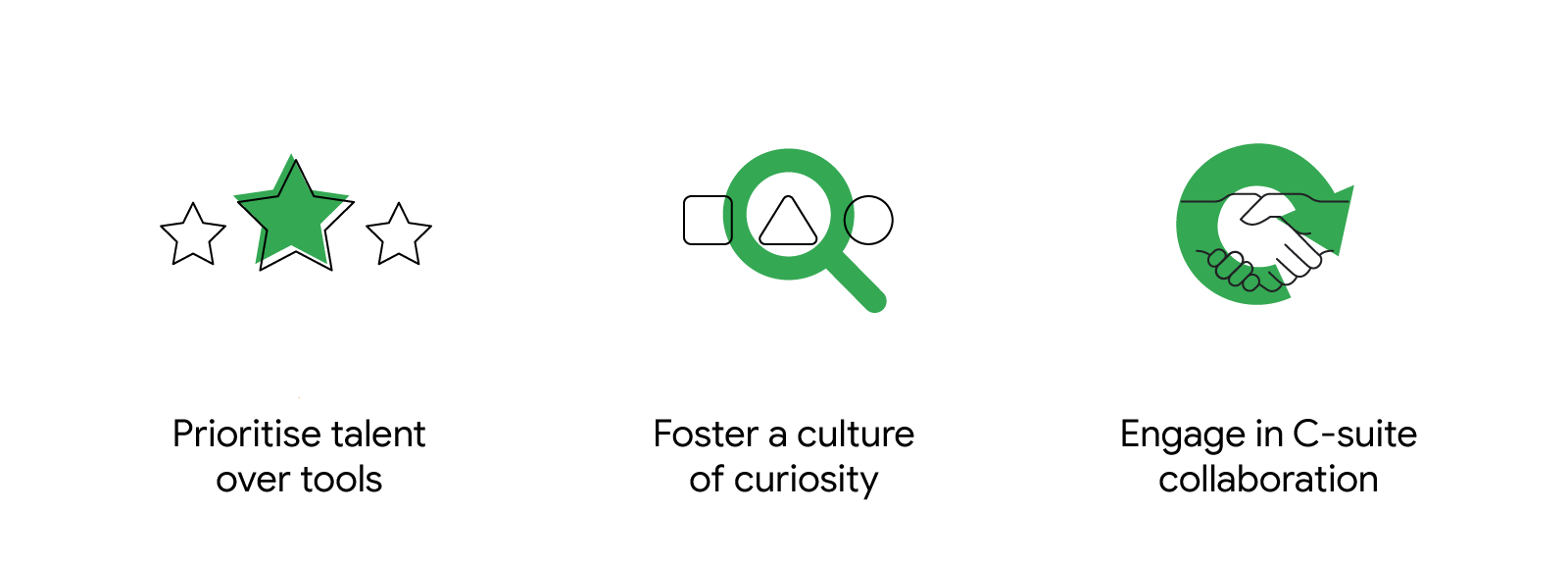Data analytics should be top of mind for every advertiser, but building a successful and effective analytics team can be challenging. Here, Google marketing and analytics leaders break down key principles businesses can use to realise the potential of a tech-savvy analytics team.
Digital transformation — the process of using digital technologies to modernise business performance, agility, and sustainability — is widely seen by marketing leaders as the key to future-proofing organisations.
To get the most out of digital innovations, companies must be able to pinpoint where to focus their efforts and to understand what strategies are working best. That’s why a strong data analytics team that can communicate real-time data insights to the C-suite is crucial to driving meaningful digital transformation.
Companies that build a successful analytics team are more likely to see revenue, profit, and market share gains.1 Yet, according to the Digital Maturity Benchmark, only 9% of businesses use insights and technology effectively to create better consumer experiences. Why?
Through Google’s own experience building world-leading analytics teams and our work with hundreds of other companies, we’ve identified three core principles that can help businesses overcome challenges and build successful analytics strategies and teams.

1. Prioritise talent over tools
When it comes to investing in your organisation’s analytics, prioritise people over tools. Investing in people leads to a flexible analytics capability, which can adapt to a changing business environment without locking the organisation into an unwieldy system of software and tools.
While many Fortune 500 companies have made great investments in analytics tools, most still struggle to make meaningful data-driven business decisions. That’s largely because this investment strategy makes the mistake of thinking that tools, rather than people, are the solution to building better analytics. The tools themselves can only go so far without the right people behind them.
It’s the analytics team who transforms the raw data into actionable insights.
These misplaced efforts led us to develop a 10/90 rule for web analytics success: Invest 10% of the analytics budget in tools and the remaining 90% in people. For example, if you’re paying a web analytics vendor $25,000 for an annual contract, you should be prepared to invest a further $225,000 in people to get meaningful value from that data.
To be sure, software systems and vendor professional services are important components of a successful analytics team. But it’s the analysts, not the tools, who transform raw data into actionable insights. By following the 10/90 rule, CxOs can draw on the winning combination of computer processing power and human judgment to inform marketing activities and business decisions, and understand consumer behaviors.
2. Foster a culture of curiosity
Analytics teams thrive in dynamic environments that reward curiosity, encourage innovation, and set high expectations. Building and reinforcing this type of culture can help put organisations on a path to earning impactful returns from analytics investments.
Giving airtime to what went wrong allows the team to learn from their mistakes and see that perfection is a pipe dream.
An active analytics culture thrives when CxOs reward curiosity over perfection. Encourage analysts to challenge convention and ask questions as a method to improve quality and reduce risks. This thinking goes hand in hand with a test-and-learn mentality, where pushing boundaries through proactive experimentation helps identify what works, and optimise accordingly.
It’s also important to create a culture where failure and success are celebrated equally. Giving airtime to what went wrong allows the team to more effectively learn from their mistakes and see that perfection is an unhealthy pipe dream. This encourages an environment that holds analysts accountable for delivering quality processes and results, further helping to mitigate risk and improve marketing programmes.
3. Engage in C-suite collaboration
High-performing analytics capabilities cannot and will not happen without the full commitment of an organisation’s senior leadership. That’s why it’s crucial that leaders collaborate with analysts to understand the data behind decision-making.
C-level leaders can create an analytics-friendly environment by knowing when to collect data, presenting business challenges to analyst teams, and consistently seeking to quantify goals and objectives. Leading by example, data-savvy CxOs can show leaders that it’s better to go to analyst teams with problems to solve rather than requests for specific deliverables, championing these non-analysts to be experts in their distinct businesses — rather than analytics.
It’s crucial that leaders collaborate with analysts to understand the data behind decision-making.
Maintaining a winning analytics capability requires endorsement up and down an organisation. This sets the tone for a company that values understanding measurement solutions as well as the problem-solving expertise analysts can deliver across the organisation.
Build for today to win tomorrow
Now’s the time for businesses to establish a data-centric culture that positions them to win with analytics today and in the future. Companies that do it are more effective and efficient, earn impactful insights from their data, and can attract and retain top-tier analytics talent.
So start laying the foundation for your company’s in-house data analytics infrastructure immediately. Audit your organisation’s current analytics capabilities to identify gaps and opportunities in your marketing strategy. Then, identify what leadership you need to close gaps in capability and design by successfully implementing the principles we’ve shared.
Build your organisation’s own high-performing analytics team, and join the future-ready businesses that are taking their marketing further.







